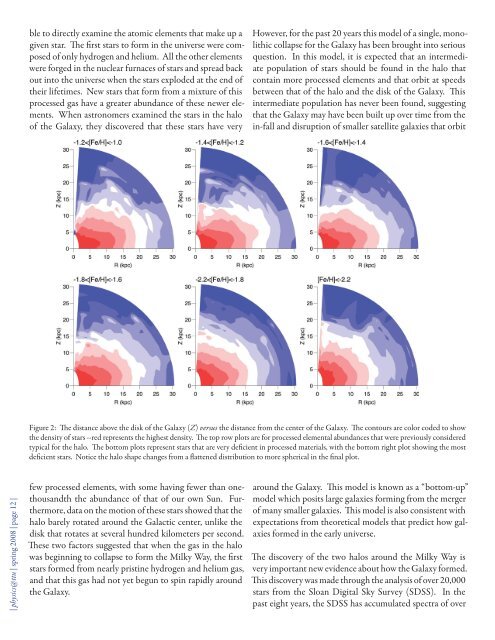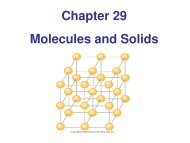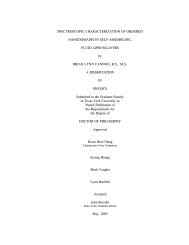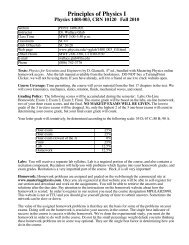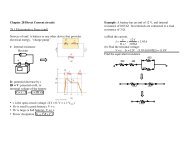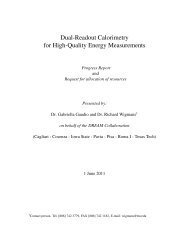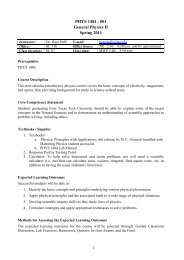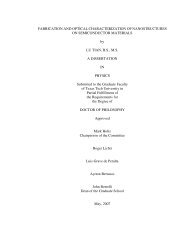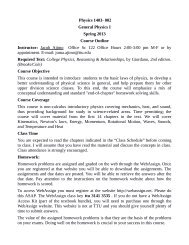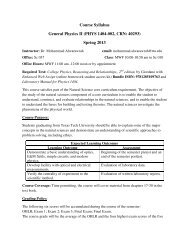Spring 2008 - Department of Physics - Texas Tech University
Spring 2008 - Department of Physics - Texas Tech University
Spring 2008 - Department of Physics - Texas Tech University
You also want an ePaper? Increase the reach of your titles
YUMPU automatically turns print PDFs into web optimized ePapers that Google loves.
le to directly examine the atomic elements that make up agiven star. The first stars to form in the universe were composed<strong>of</strong> only hydrogen and helium. All the other elementswere forged in the nuclear furnaces <strong>of</strong> stars and spread backout into the universe when the stars exploded at the end <strong>of</strong>their lifetimes. New stars that form from a mixture <strong>of</strong> thisprocessed gas have a greater abundance <strong>of</strong> these newer elements.When astronomers examined the stars in the halo<strong>of</strong> the Galaxy, they discovered that these stars have veryHowever, for the past 20 years this model <strong>of</strong> a single, monolithiccollapse for the Galaxy has been brought into seriousquestion. In this model, it is expected that an intermediatepopulation <strong>of</strong> stars should be found in the halo thatcontain more processed elements and that orbit at speedsbetween that <strong>of</strong> the halo and the disk <strong>of</strong> the Galaxy. Thisintermediate population has never been found, suggestingthat the Galaxy may have been built up over time from thein-fall and disruption <strong>of</strong> smaller satellite galaxies that orbitFigure 2: The distance above the disk <strong>of</strong> the Galaxy (Z) versus the distance from the center <strong>of</strong> the Galaxy. The contours are color coded to showthe density <strong>of</strong> stars --red represents the highest density. The top row plots are for processed elemental abundances that were previously consideredtypical for the halo. The bottom plots represent stars that are very deficient in processed materials, with the bottom right plot showing the mostdeficient stars. Notice the halo shape changes from a flattened distribution to more spherical in the final plot.| physics@ttu | spring <strong>2008</strong> | page 12 |few processed elements, with some having fewer than onethousandththe abundance <strong>of</strong> that <strong>of</strong> our own Sun. Furthermore,data on the motion <strong>of</strong> these stars showed that thehalo barely rotated around the Galactic center, unlike thedisk that rotates at several hundred kilometers per second.These two factors suggested that when the gas in the halowas beginning to collapse to form the Milky Way, the firststars formed from nearly pristine hydrogen and helium gas,and that this gas had not yet begun to spin rapidly aroundthe Galaxy.around the Galaxy. This model is known as a “bottom-up”model which posits large galaxies forming from the merger<strong>of</strong> many smaller galaxies. This model is also consistent withexpectations from theoretical models that predict how galaxiesformed in the early universe.The discovery <strong>of</strong> the two halos around the Milky Way isvery important new evidence about how the Galaxy formed.This discovery was made through the analysis <strong>of</strong> over 20,000stars from the Sloan Digital Sky Survey (SDSS). In thepast eight years, the SDSS has accumulated spectra <strong>of</strong> over


